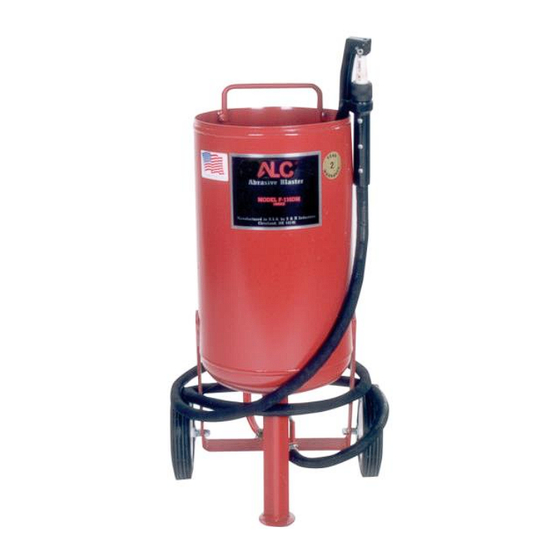
Advertisement
Quick Links
Advertisement

Summarization of Contents
General Warnings and Dust Hazards
Silicosis and Other Dust Warnings
Dangers of breathing silica dust, silicosis, and other fatal lung diseases. Mandates NIOSH-approved supplied-air respirators.
Respirator Limitations and Air Quality
Supplied-air respirators don't protect against CO; use monitoring devices. Ensure grade D quality air following OSHA standards.
Assembly Instructions
Wheel Assembly and Hose Connections
Steps for attaching wheel assemblies and connecting abrasive and air hoses using pipe dope for sealing.
Deadman Valve Assembly and Adjustments
Details on assembling the Deadman Valve, adjusting the sealing block, and inspecting nozzle washers.
Critical Hose Disconnection Warning
Warning against disconnecting hoses while under pressure due to risk of serious injury or death. Use safety lock pins.
Pressure Blaster Safety Procedures
General Operation Safety
Precautions include not placing body parts in seals, not exceeding 110 PSI, and wearing respirators post-blasting.
Personal Protective Equipment (PPE)
Mandates wearing safety glasses, gloves, and NIOSH-approved respirators during operation and servicing.
Operational Safety Practices
Advises on using backboards for overspray, working in open areas, and never leaving pressurized machines unattended.
Equipment Handling and Maintenance Safety
Covers safe draining, preventive maintenance, not splicing hoses, and avoiding welding/grinding on the vessel.
Hazardous Environment Restrictions
Prohibits use near explosives or flammable substances due to static electricity risk. Do not overfill tank with media.
Operating Instructions and Techniques
Air Hose and Pressure Setup
Connect air hose (min 1/2" I.D.), ensure valves are OFF, then open air inlet to pressurize between 40-110 PSI.
Abrasive Media and Flow Control
Use fine grade abrasive. Squeeze Deadman Valve fully, then slowly adjust regulator for visible abrasive flow.
Operating Technique Warnings
Warning that bystanders must stay clear due to potential startling noise from pressure release or venting abrasive.
Nozzle Selection and Usage
Nozzle Selection Chart
Provides a chart correlating part number, nozzle I.D., CFM, PSI, blast area coverage, and abrasive usage.
Nozzle and Holder Inspection Warning
Inspect nozzle threads and holder for wear. Worn washers can cause thread erosion and nozzle ejection.
Air Compressor and Abrasive Recommendations
Air Compressor Operation Guidelines
Tips for efficient operation: use smaller nozzles, don't blast continuously, use adequate air hoses, and keep air dry.
Abrasive Media Storage and Use
Keep media dry to prevent blaster damage. Store on skids, not directly on floors. Do not use sand.
Abrasive and Pressure Guide
Material Cleaning Guide
Table correlating materials to be cleaned with recommended air pressure, abrasive type, and grit size.
Abrasive Material Descriptions
Details on Coal Slag, Steel Grit, Glass Bead, Aluminum Oxide, Plastic Grit, and Walnut Shells for various applications.
Troubleshooting Tips
Blast Flow Issues
Solutions for surging blast flow (low pressure, too much media) and excessive media consumption.
Clogging and Moisture Problems
Troubleshooting for clogged flow (debris, media size, wet media) and moisture in abrasive or air.
Compressor and Air Pressure Issues
Addresses overtaxed compressors, lack of air pressure (small compressor, leaks, plugged filters).
Abrasive Flow and Kinked Hose
Solutions for lack of abrasive flow, including empty tank, moist media, low pressure, kinked hoses, or debris.
Maintenance Procedures
Pre-Maintenance Safety Steps
Critical safety steps before maintenance: depressurize, disconnect power, bleed air, lockout/tagout supply.
Component Replacement Schedule
Recommendations for replacing hose adaptors, sealing blocks, nozzles, and checking urethane gaskets.
Hose and Coupling Integrity
Inspect abrasive hose for softening or leaks. Check couplings for tight fit to prevent disconnection under pressure.
Parts List and Diagrams
Comprehensive Parts List
Detailed list of all part numbers, descriptions, and item numbers for the pressure blaster components.
Replacement Parts Diagram
Schematic diagram illustrating the location of replacement parts on the pressure blaster and Deadman Valve.
Warranty and Legal Information
Disclaimer of Warranties
States seller's limited express warranties and disclaims all implied warranties, including merchantability.
Indemnification Agreement
Buyer agrees to indemnify seller against claims arising from product use, regardless of seller's fault.
Limited Warranty Terms
Two-year warranty against defects in materials/workmanship, excluding abrasive wear parts and misuse.




Need help?
Do you have a question about the 40005 and is the answer not in the manual?
Questions and answers